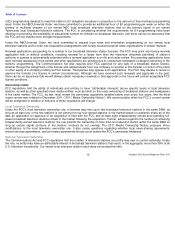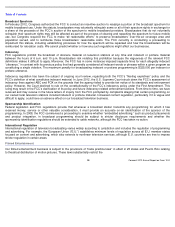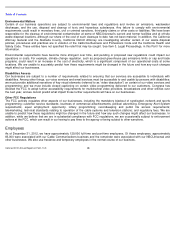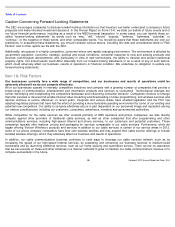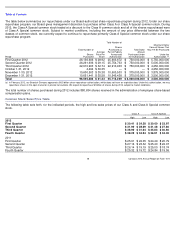Comcast 2012 Annual Report Download - page 36
Download and view the complete annual report
Please find page 36 of the 2012 Comcast annual report below. You can navigate through the pages in the report by either clicking on the pages listed below, or by using the keyword search tool below to find specific information within the annual report.
Table of Contents
We also obtain a significant portion of our content from third parties, such as movie studios, television production companies, sports
organizations and other suppliers. Competition for popular content, particularly for sports programming, is intense, and we may be
forced to increase the price we are willing to pay or be outbid by our competitors for popular content. Entering into or renewing
contracts for such programming rights or acquiring additional rights may result in significantly increased costs. Moreover, particularly
with respect to long
-
term contracts for sports programming rights, our results of operations and cash flows over the term of a contract
depend on a number of factors, including the strength of the advertising market, our audience size and the timing and amount of our
rights payments, and there can be no assurance that revenue from these contracts will exceed our cost for the rights, as well as the
other costs of producing and distributing the programming. If our content does not achieve sufficient consumer acceptance, or if we
cannot obtain or retain rights to popular content on acceptable terms, or at all, our businesses may be adversely affected.
The loss of NBCUniversal’
s programming distribution agreements, or the renewal of these agreements on less favorable
terms, could adversely affect its businesses.
Our cable networks depend on the maintenance of distribution agreements with multichannel video providers. Our broadcast
television networks depend on the maintenance of network affiliation agreements with third-
party local broadcast television stations
in the markets where we do not own the affiliated local broadcast television station. In addition, every three years, each of our owned
local broadcast television stations must elect, with respect to its retransmission by multichannel video providers within its DMA, either
“must-carry” status, in which the distributor’
s carriage of the station is mandatory and does not generate any compensation for the
local station, or “retransmission consent,”
in which the station gives up its right to mandatory carriage and instead seeks to negotiate
the terms and conditions of carriage with the distributor, including the amount of compensation (if any) paid to the station by such
distributor. In the course of renewing distribution agreements with multichannel video providers, we may enter into retransmission
consent agreements on behalf of our owned local broadcast television stations. All of our NBC and Telemundo owned local
broadcast television stations have elected retransmission consent for the period January 1, 2012 through December 31, 2014.
Increasingly, our cable networks, broadcast television and filmed entertainment businesses also have entered into agreements to
license their prior season and library content on other distribution platforms. There can be no assurance that any of these
agreements will be renewed in the future on acceptable terms, or at all. The loss of any of these agreements, or the renewal of these
agreements on less favorable terms, could reduce the reach of our television programming and its attractiveness to advertisers,
which in turn could adversely affect our cable networks, broadcast television and filmed entertainment businesses.
Our businesses depend on keeping pace with technological developments.
Our success is, to a large extent, dependent on our ability to acquire, develop, adopt and leverage new and existing technologies,
and our competitors’
use of certain types of technology and equipment may provide them with a competitive advantage. For
example, some companies are building fiber-optic networks that provide significant high-
speed Internet access speeds and wireless
Internet technologies continue to evolve rapidly. We expect other advances in communications technology to occur in the future. If
we choose technology or equipment that is not as effective, cost
-
efficient or attractive to consumers as that employed by our
competitors, if we fail to employ technologies desired by consumers before our competitors do so or if we fail to execute effectively
on our technology initiatives, our business and results of operations could be adversely affected. Moreover, changes in the products
and services that our competitors offer may require that we offer certain of our existing services or enhancements at a lower or no
cost to our customers or that we make additional research and development expenditures, which could have an adverse effect on
our businesses.
33
Comcast 2012 Annual Report on Form 10-
K


